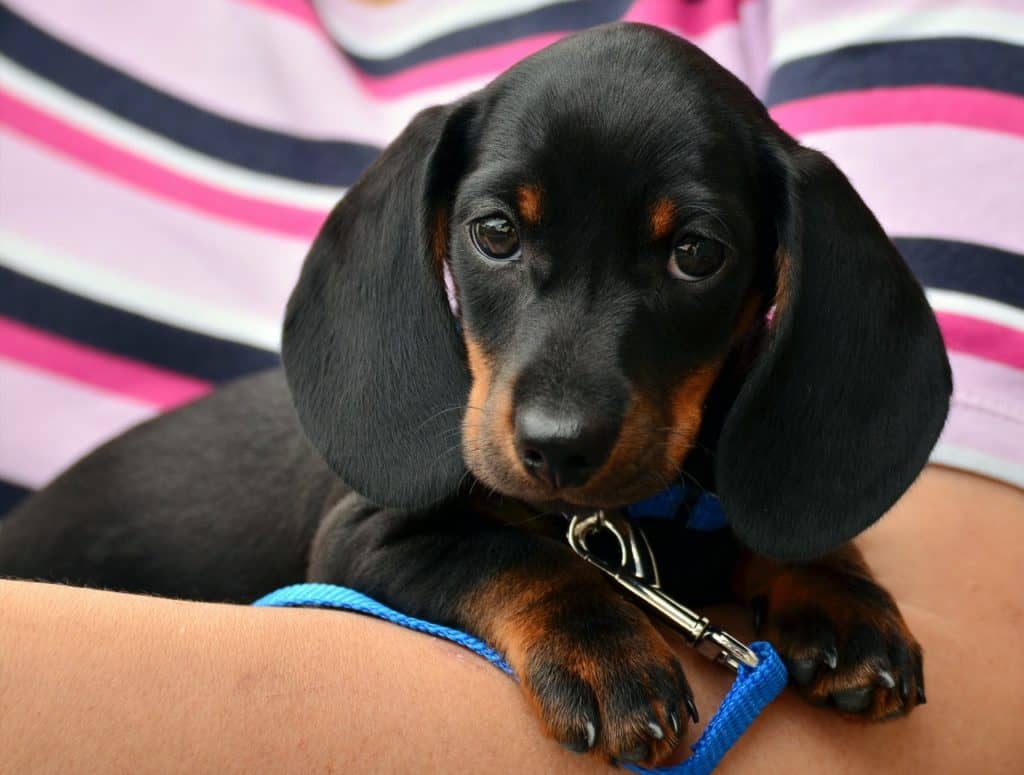Without a doubt, grooming is a vital aspect of your puppy’s life and this significantly includes nail trimming. Properly trimmed nails are a clear sign of his good health, hygiene, and overall well-being. Hence, it is important for us to know how to trim puppy nails safely.
AT A GLANCE (SEE ON AMAZON):
- Scissor Style Nail Trimmer: Nail Trimmer for Dogs
- Guillotine Style Nail Trimmer: Deluxe Dog Nail Clippers
- Nail Grinder: Cordless Dog Nail Grinding Tool
- Nail Clipper: Pet Nail Clippers for Small Animals
- Nail File: ‘PallyPad Mini’ Dog Nail File
Why is it Important to Trim Puppy Nails?
More than the cosmetic concern, overgrown nails greatly decrease the overall quality of your puppy’s life.
As the nail hits the ground, the pressure puts force on the foot and leg structure. When these nails get too long, it can lead to pain, inflammation, and other serious discomforts like difficulty walking, lameness, or adverse injury. They can turn a sound paw into a splayed foot and reduce traction which results in injured feet and tendons.
Over time, your pooch might develop spine and posture problems due to frequently shifting weight. This can generally limit his mobility. In rare instances, it can trigger irreversible damage.
It must be integrated into every puppy’s grooming routine to prevent their claws from tearing, splitting, or affecting his gait as he roams around. Even if he has little nails on a small paw, it does not have to be traumatic.

When Can You Start Cutting A Puppy’s Nails?
Start to clip your puppy’s nails around six weeks of age. There is not much to cut yet. But, this will establish a routine so that by the time he needs a proper trim, he will be well-adjusted to it.
The interval between clipping sessions is dependent on how fast your puppy’s nails grow. This is affected by factors such as genetics, breed, feeding habits, and activity level.
If he is active and spends a lot of time outside, goes for regular walks, or runs on hard surfaces like concrete or asphalt, his nails will wear down naturally due to friction. This means you can lessen the frequency of clipping.
In order to maintain the ideal nail length, typically expect to clip once every three to four weeks in order to prevent mishaps.
If they touch the ground, you hear his nails clicking or see him turn sideways, then they are too long, and it is time for clipping.
How do you trim a puppy’s nails?
What is the proper way to trim a dog’s nails?
Learning how to safely clip your pooch’s nails will be more manageable with our comprehensive guide.
Learn all you need to know about proper puppy nail trimming below with some additional tips on taking care of your fur baby’s paws.
Here’s how to trim your puppy’s nails safely.
Step1: Make Your Puppy Comfortable
Be sure to hold your puppy comfortably. If he jerks, tries to run, bites, or scratches, you could injure each other or people and pets nearby.
These can be avoided by teaching him to get accustomed to having his feet handled. The less he fidgets, the easier the task will be. Begin early on to lessen his anxiety or fear by frequently and gently touching his paws.
Repeat this several times a day for a few days until he stays calmly on your lap and allows you to hold and massage all four paws, toes, and toenails.
Step 2: Prepare the Equipment
Can I cut my puppy’s nails with human nail clippers? There are several nail trimmers and trimming tools specifically used for dogs and puppies. But you can use the one you are most comfortable with or whatever works best for your pup.
These tools include scissor-type trimmers, guillotine style nail trimmer, and nail grinder. You might want to prepare as well some accessories that would help you accomplish the task like a nail file or emery board, styptic powder, and a flashlight, maybe. Don’t forget the dog treats too.
Step 3: Familiarize Your Dog With the Trimming Tool
Introduce your puppies to the trimming tool beforehand to get them used to it. This will make them more cooperative and easier to handle during your session.
Start slowly but surely to familiarize him with its appearance, feel, sound, rotation, and smell before attempting to use it on his nails. Let him sniff and explore the tool while you encourage him with comforting words and praises.
Hold a small treat in the same hand as the clipper or grinder, and he will find his reward while he investigates. Condition him to adjust to it by repeating this every day until he willingly allows you and does not seem to mind.
Pretend to go through the motions of clipping to help your puppy get accustomed to the whole process.
Step 4: Determine Where to Cut
Again, hold your dogs in a comfortable position. For medium to large-breed puppies, it is easier if you hold them on your lap. Tuck his body into the crook of your arm to keep your hands free. For small breeds or little puppies, you can hold them on your lap or put them on a table or couch.
Grasp your puppy’s paw with your less dominant hand. Push back any fur growing around the nail or, better yet, tie the hair between the paws. This gives you a better view of where you are cutting, reduces irritants sticking to his delicate feet, and avoids them from getting caught by the trimming tool.
Examine your puppy’s nails before you cut them. A canine nail consists of the hard outer material called the “shell” and the pink line or “quick” that supplies blood and runs through the center of the nail bed.
The perfect cutting range ends right before the blood supply so you must avoid cutting into the “quick”. Make sure to clip right past the pink line or “quick”.
However, it can be difficult if your pup has dark nails. You might need to use a flashlight to better see a chalky white ring or clip just below where the nail curves downwards. For your puppy’s well-being and easy maintenance, a short quick is a preferred length.
Step 5: Get to the Actual Trimming Process
Place your thumb on top of the foot and your other fingers underneath while applying gentle pressure to spread the toes. Grab each toe and lightly squeeze the paw pads to extend the nail.
With the trimming tool in your dominant hand, snip a little, just at the end part of the nails, straight across with quick, decisive strokes. If using a grinder, grind across the bottom part of the nail and then carefully in from its tip, smoothing rough edges.
Do this one at a time, right where the nail starts to curve, as the “quick” usually has not grown past that. Support your puppy’s toe firmly but gently.
Give him a treat, and while he is chewing, trim one nail. Praise your puppy then give him another reward as you trim the next one.
You may opt to file your dog’s nails with an emery board to remove sharp edges. Others rely on filing alone if their dog is afraid of clippers or is not comfortable with the process. However, it is more time-consuming and inefficient.
Normal canine nails should be intact all the way into the foot, not bleeding, cracked, or split. If there is no bleeding at the end of the whole process and your puppy behaves well, congratulations because you have done everything correctly!
Step 6: Reward Your Fur Baby
When the job is done, do not forget to provide your puppy with a lot of positive reinforcement. Give him lavish praises and treats or even some playtime.
Through this, he will associate the trimming of his nails with a positive and rewarding experience. He will be more relaxed and behave in anticipation of the reward during future sessions.

What if There is Bleeding after Nail Trimming your Puppy?
Despite being careful, it is possible that you might make a mistake as you nail trim your puppy. Do not panic when it happens.
Instead, apply a small amount of pressure to the end of the nail to stop the bleeding and prevent dirt from contacting the wound to avoid infection. If bleeding does not stop after 30 minutes, contact your veterinarian. Otherwise, put styptic powder or pencil on the wound for coagulation, or try applying some ice cubes if you do not have the clotting powder.
Be sure to cuddle, fuss, and reassure your puppy when this painful accident happens. Leave the rest of the nails for some other time because he will be agitated at this point and you do not want to risk hurting him again.
Seeking Professional Help
As always, to address your concerns regarding your puppy’s nails, paws, or overall health, it is advisable that you consult with your veterinarian first. He will be able to provide you with the best recommendations and treatment for your pooch.
In this case, when it is too stressful for you to trim your puppy’s nails, ask your veterinarian for a routine appointment or take your pup to a professional dog groomer.
You can get them to show you how to do it. It would help you to be well-prepared to cut your dog’s nails by yourself next time.
Final Words
By choosing to personally groom your puppy, you are not only maintaining his good health and hygiene. You also learn valuable lessons in patience and animal care firsthand.
As always, it is imperative that you prioritize your dog’s safety and comfort. Each dog has a unique level of sensitivity or tolerance so please be patient with him.
With our concise guide here, it will be easier for you to safely trim away those puppy nails. After you have consistently followed through with it several times, both you and your pup will become a pro at this. And your canine buddy’s nails will be tidy all the time!
